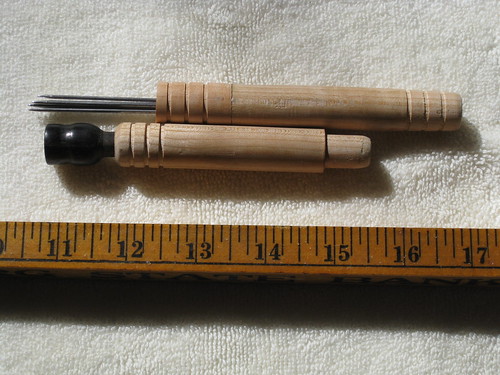When I first asserted that knit "sweaters" were a regular part of a seaman's regular wear, I was told that they took too long to knit to be practical. However, I have shown that using gansey needles and a knitting sheath such a weatherproof garment can be knit in well under a hundred hours.
Then, I was told that such garments could only have been made after the advent of mill spun because it would have taken too long to spin the appropriate yarn by hand. So, I got a spinning wheel and learned to spin. In my tests, it is quite possible to hand spin worsted 5-ply (gansey) yarn, and it takes well under a hundred hours to prepare the yarn for one good seaman's sweater. Thus, the total time from sheep to sweater for a hand-spun, hand-knit seaman's sweater is well under 200 hours.
Assuming uncoated long wool such as Kent, this includes, a day to wash the wool, a day to dye the wool, 16 hours to comb the wool, 50 hours of spinning and plying, and 20 hours of "yarn management". I am confident that the spinning could be done in this time on either a flier type spinning wheel or drop spindles. Yarn management tools in my calculation are limited to niddy-noddies and hand wound balls. Groups working together (i.e., neighbors) could reduce the required time substantially. For example, 4 house holds working to together could easily dye 4 lots of wool in one day, reducing that time requirement by 6 hours. Professional textile workers or well to do households would have had other tools to improve productivity.
Never the less, it might well have taken 800 hours of hand labor (spinning & knitting) to produce the knit contents of a 15th century seaman's bag including: 2 knit frocks, socks, mittens, hood, and neck warmer. Some of these items would have to be renewed each year, and some would last for several seasons. Some items such as fisherman's nipper's would have been cut from old socks. And, there would have been pants made of woven wool. Seaman required specialized clothing to pursue their trade. This clothing was the seaman's tools of the trade, like a blacksmith's forge and tools or a carpenter's tools.
In addition, the bag would contain clothes to wear ashore, as the clothes worn on-board would have become highly soiled.
Then, I was told that such garments could only have been made after the advent of mill spun because it would have taken too long to spin the appropriate yarn by hand. So, I got a spinning wheel and learned to spin. In my tests, it is quite possible to hand spin worsted 5-ply (gansey) yarn, and it takes well under a hundred hours to prepare the yarn for one good seaman's sweater. Thus, the total time from sheep to sweater for a hand-spun, hand-knit seaman's sweater is well under 200 hours.
Assuming uncoated long wool such as Kent, this includes, a day to wash the wool, a day to dye the wool, 16 hours to comb the wool, 50 hours of spinning and plying, and 20 hours of "yarn management". I am confident that the spinning could be done in this time on either a flier type spinning wheel or drop spindles. Yarn management tools in my calculation are limited to niddy-noddies and hand wound balls. Groups working together (i.e., neighbors) could reduce the required time substantially. For example, 4 house holds working to together could easily dye 4 lots of wool in one day, reducing that time requirement by 6 hours. Professional textile workers or well to do households would have had other tools to improve productivity.
Never the less, it might well have taken 800 hours of hand labor (spinning & knitting) to produce the knit contents of a 15th century seaman's bag including: 2 knit frocks, socks, mittens, hood, and neck warmer. Some of these items would have to be renewed each year, and some would last for several seasons. Some items such as fisherman's nipper's would have been cut from old socks. And, there would have been pants made of woven wool. Seaman required specialized clothing to pursue their trade. This clothing was the seaman's tools of the trade, like a blacksmith's forge and tools or a carpenter's tools.
In addition, the bag would contain clothes to wear ashore, as the clothes worn on-board would have become highly soiled.

.jpg)